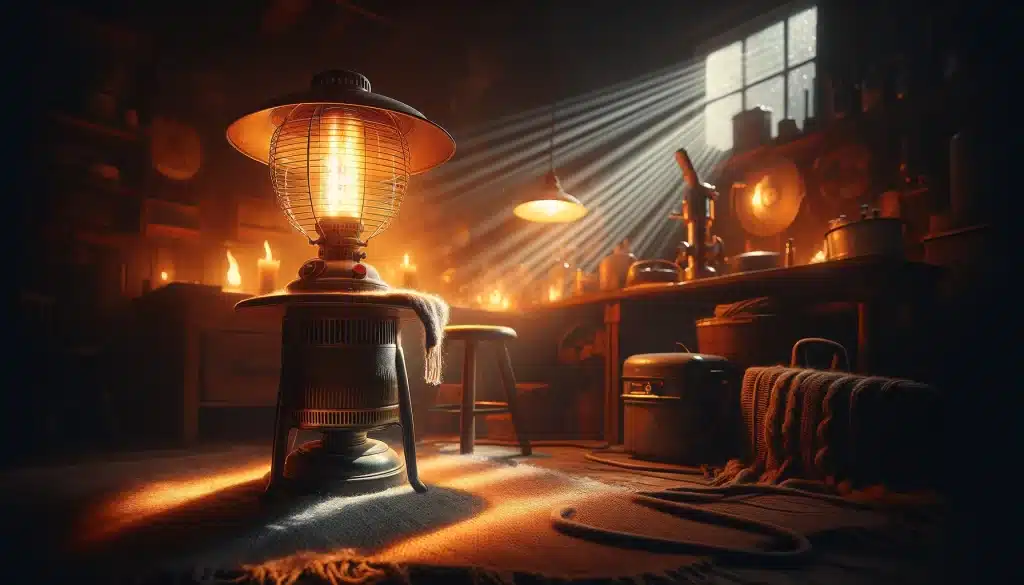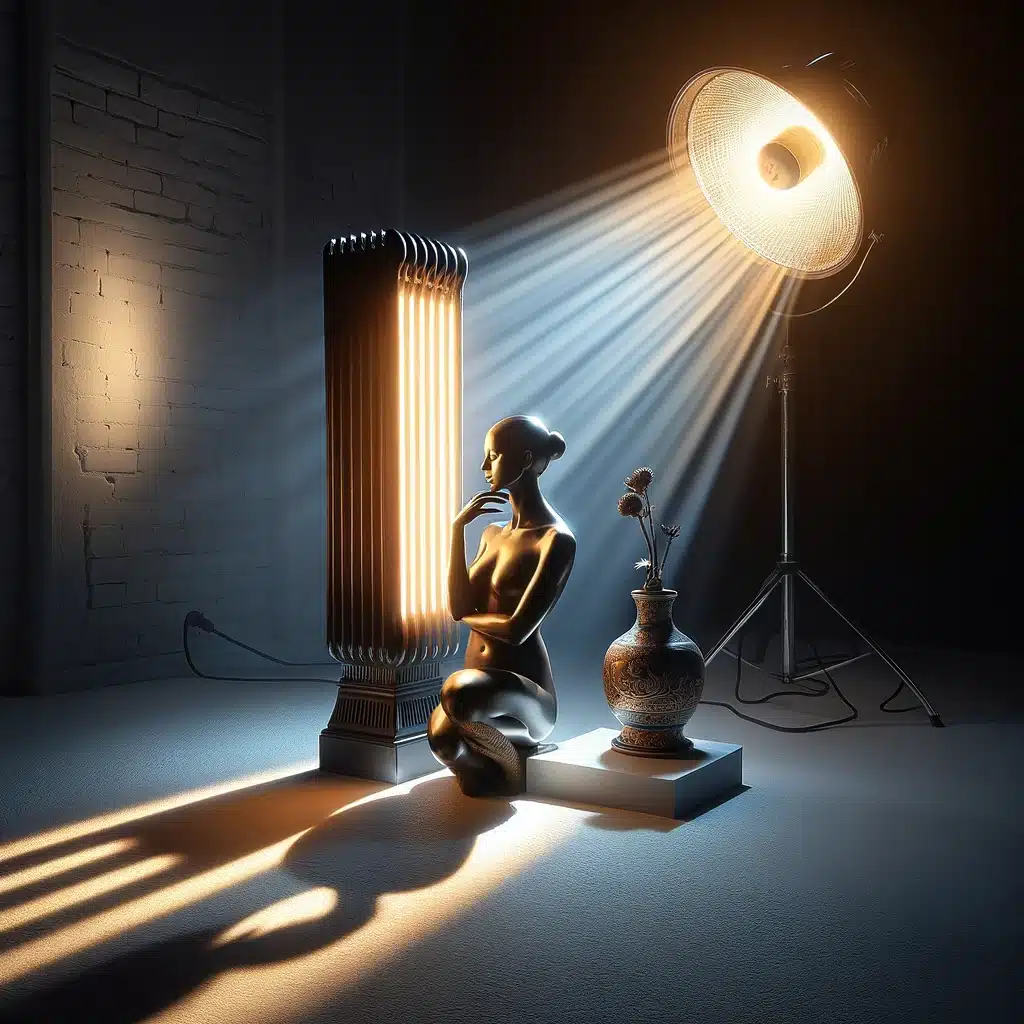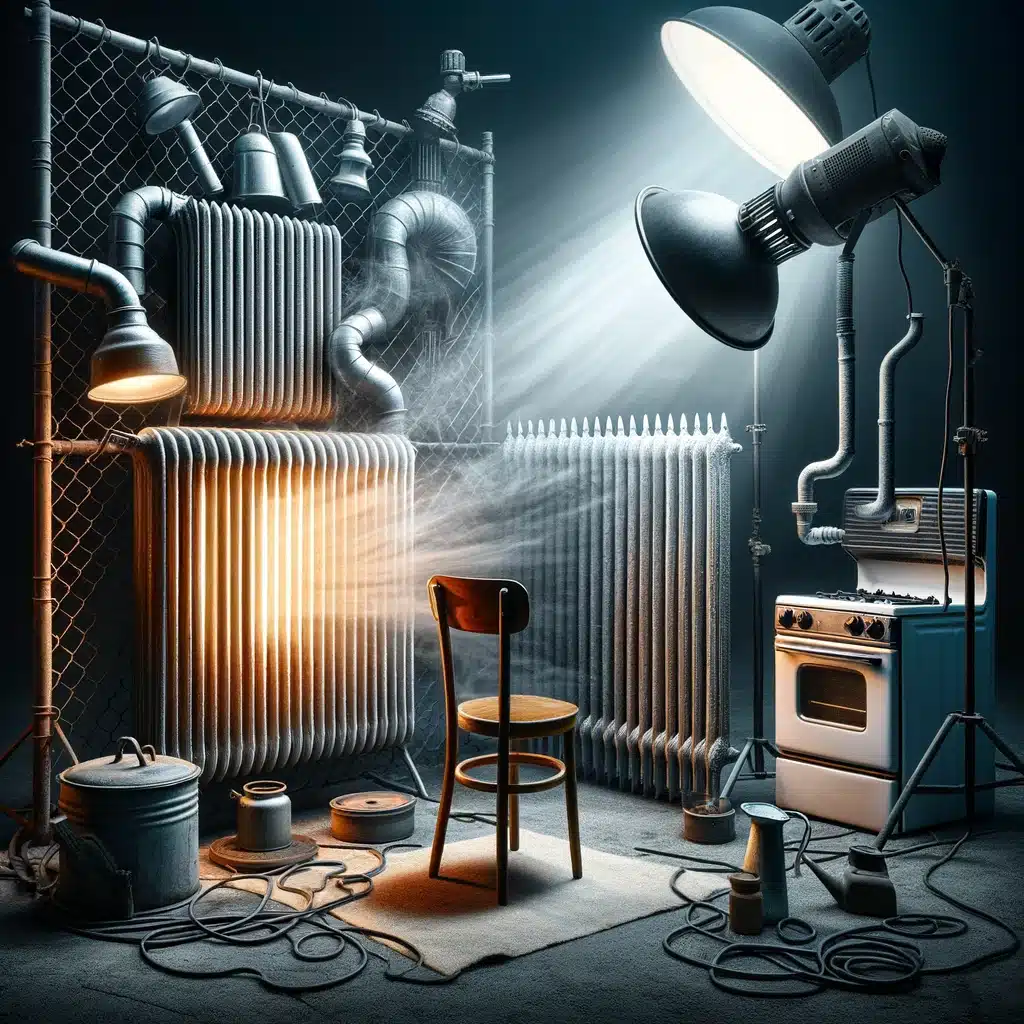Photography is all about capturing light. Photographers are obsessed with chasing the perfect natural light, waiting for a magic hour when the sun’s rays are soft and diffuse. But what about creating our own light? Artificial light allows us to shape the mood and atmosphere of an image. And heaters, which emit a warm incandescent glow, are one of the most effective tools for introducing intimate warmth into a scene.

In this article, we’ll explore how heaters can transform the ambiance in fine art photography. Heaters create hot spots that draw the viewer’s eye and set a cozy tone. The warm light acts as a storytelling device, implying narratives of comfort and relationships. We’ll look at ways photographers creatively use heaters as light sources and props to add heat and color to an image. From classic tabletop heaters in a home to unexpected objects like industrial burners, heat introduces a sense of humanity into a photograph.
So let’s examine how photographers harness the illuminating warmth of heaters to set the scene and enhance visual storytelling.
The Science Behind Heater Light
Before diving into art, let’s understand why heater light looks the way it does. Most heaters utilize glowing metal wires or tubes to emit light. This incandescent light (produced by heat) emits a continuous band of color from red to yellow and white. The peak wavelength falls in the red/orange zone at about 1000K color temperature, giving heaters their distinctive warm glow.
This is different from daylight or flash which have a cooler color balance around 5500-6000K. The yellow/red bias of incandescent light triggers an association with fire and heat in our brains. We can exploit these color properties for creative effects in photography.
Drawing the Eye with Hot Spots
Heaters create hot spots – areas of intense brightness that naturally catch the viewer’s eye. Photographers often place their key subjects near or within these hot spots to direct attention. The fall-off between hot zones and shadow creates depth and modeling.

Backlighting with a heater produces bold rim light around subjects, separating them from the background. The eye is magnetically pulled toward these rings of light. Heaters also cast strong directional shadows, which add drama.
Contrast of Warm and Cool
The warm glow of heaters stands out against cooler surroundings. This contrast between warm and neutral tones is visually striking.
In monochrome photography, a heater introduces luminosity and tonality. Steve Schapiro’s photograph of Martin Luther King by a hotel room heater uses this effect to draw the eye to King’s pensive face.
Color photographers can amplify the orange cast against blueish scenes. Philippe Halsman’s portrait of Salvador Dali beside a glowing heating element utilizes this complementary color contrast for surreal intensity.
Heaters as Sources
Photographers have many choices when using heaters as light sources. Small tabletop heaters provide close-up pools of light. An industrial burner or oven emits bold streaks of color and falloff.
Light quality shifts relative to distance – close up, the direct lighting is almost abstract. Backing away shows recognizable objects with dimensional modeling.
Light intensity also varies across different heat sources – a burning log fire, an old radiator, or a red neon sign all have unique qualities. There’s great flexibility in how heaters are positioned and mixed with ambient light.
The Narrative of Warmth
Beyond their practical lighting uses, heaters also carry symbolic meaning that can enhance the narrative of an image. Warmth represents comfort, safety, and domesticity. Light and shadow suggest the passage of time. There’s an innate human connection with fire and the hearth.
Photographers leverage these connotations in fine art and documentary imagery. A glow visibly radiates intimacy in a couple’s portrait. Sun rays streaming through a dusty attic heater evoke fading memories. References to heat introduce metaphor and storytelling.
Inviting and Personable
Heater lighting crafts an inviting mood that feels personable to the viewer. The warm tones and textures make subjects approachable and down-to-earth. Skin appears softer, and more flattering.
There is a casual, fireside conversation vibe created when people are lit with the ambiance of heaters. Irving Penn’s artful portraits demonstrate this friendly realism by photographing his subjects near stove fires and radiators.
Cozy Atmosphere
The warmth of heaters sets an intimate, cozy atmosphere in the context of indoor scenes. Radiators and fireplaces trigger a comforting, familiar environment in photos of living rooms, reading nooks, offices, and other domestic spaces.
This works for product photography as well, making items seem accessible when seen lit attractively by tabletop heaters and lamps. Food becomes more appetizing and nostalgic.
Character of Old Objects
Antique cast iron radiators, vintage lamps, and other weathered heaters impart a rustic, timeworn character that adds to the storytelling of a photograph. Their aged patina expresses the charm of imperfect objects that have been well-used over time.
Conveying this history and heritage amplifies the overall ambiance. Salvaged heating artifacts work for either period-specific contexts or eclectic, mismatched settings.
Moody Atmosphere
The dancing flames and animated glow of heaters bring a moody, atmospheric vibe to artistic photography. Their chaotic, flickering light contrasts with steady ambient illumination. Photos can utilize this energy to convey emotion.
Dark, shadowy images lit primarily by single-source heaters project a broody, romantic sentiment. The light feels more organic and spontaneous than off-camera flash.
Psychological Effects
Research has shown that warm-hued lighting, around 2000K, has measurable psychological effects – it makes spaces feel more welcoming and people more sociable. Cool-white lighting above 4000K can feel sterile and impersonal by comparison.
Photographers can use these subconscious effects strategically, relying on heaters alone to light a convivial group scene. Or combine with cool tones to isolate subjects psychologically. Light color impacts mood.
Celebratory and Festive
The holidays are a perfect time to harness heaters’ festive flair. Strings of Christmas lights and candles on a menorah create celebratory motifs. A yule log fire radiates seasonal coziness and tradition.
Heaters also work for other festive events beyond winter holidays. Colored gels on hot work lights add a vivacious spirit to birthday parties or dance floors. The conviviality of heat lighting sets a joyous tone.
Safety Considerations
When incorporating heaters into shoots, firefighters strongly recommend keeping safety top of mind. Use only UL/ETL-certified equipment and avoid leaving hot lights unattended.
Position heaters a minimum distance from people and flammable objects. Direct plug-in electrical heaters are safer than open flames. And remember, the equipment stays hot after powering off!
Styling with Heaters
There are endless options for creatively styling heaters to complement photographic themes. Painterly effects come from aiming work lights through translucent objects. Position an industrial heater behind a chainlink fence for striking shadows.

Using household heaters in unexpected ways also adds intrigue – place a vintage radiator in an outdoor setting, or turn a stove burner on a chair. Imaginative styling plays with context.
Enhancing Thematic Elements
Even in photos without visible heaters, we can enhance thematic elements with carefully controlled warmth. Illuminating the subjects’ face in an introspective portrait or just their hands enhances the focus subtly.
For indoor scenes, we might paint several lamps and practicals with orange gels instead of full tungsten balancing. This retains a bit of moodiness. Heat conveys emotion.
Mixing with Cool Light
Balancing heater sources against ambient cool light creates visual interest through contrast. We can mix color temperatures on opposite sides of a room, or limit heaters to accent lighting.
Working at dusk lets us mix vibrant sunsets and streetlights with the flood of warmth from interior fixtures. Matching intensities as ratios rather than fully overpowering ambient keeps things natural.
Composing Around Heaters
Thoughtful composition with heaters in mind enhances their impact. Placing subjects in the foreground with heaters behind them reveals the sources. Or we can hide heaters behind objects for backlighting.
Lens flare from a heater directly in front adds liveliness. A wide shot can use heaters to frame a cozy scene. Their positional relationship to key elements matters compositionally.
Acting as Natural Accents
To make heaters seem like natural parts of a scene, we can utilize them as practical accents that would belong – such as parked cars with running headlights outside a diner, or including lamps in bedroom scenes.
This embedded approach prevents heaters from feeling artificially injected just for lighting effects. They instead serve roles that reinforce the reality of the spaces portrayed.
Portraying Temperature
Creative framing and composition can visually portray environmental temperature within a photo. Warm foregroundsubjects against cool distant backgrounds imply winter. Radiant heat against black conveys intensity.
We can encourage authentic expressions – cold hands shoved in pockets, cozying by a fireplace, sipping hot drinks. This heightens the impression of thermal conditions within a space.
Humanizing with Imperfections
The imperfections of practical heaters lend organic authenticity that humanizes photography. Glowing coils, uneven light distribution, and lens flare caused by real bulbs differ from perfect studio strobes. There is beauty in flaws.
Letting the rough edges show rather than diffusing into blanket evenness retains natural texture. Keeping things imperfect helps convey a comfortably realistic, unstrategic mood.
Locations That Suit Heaters
Certain locations inherently suit the use of heaters for thematic effect. Winter settings like ski lodges and snowy landscapes beg for cozy, warming light. Similarly, old castles and historic sites evoke the use of period heating.
Bars, restaurants and nighttime settings typically have ambient practical fixtures for accenting patrons with moody illumination. We can also introduce heaters to locations lacking them for contrast.
Conveying Isolation
In addition to warmth and comfort, heaters can also convey a sense of isolation in the right contexts. A sole table lamp in an empty home or a campfire far from city lights suggests solitude. Even people together can seem isolated and preoccupied if only illuminated by solitary fixtures.
Single-point light sources cast most of the scene into shadow, fragmenting and disconnecting subjects from their surroundings. This heightens seclusion.
Heaters as Props
Sometimes heaters feature prominently as photographic props rather than only lighting tools. Vintage equipment like radios, lanterns, and cooking ranges add heritage character.
Thematic scenes like a camping trip benefit from using period-appropriate propane tanks and camp stoves. There’s storytelling value in the features of old heaters beyond their emission of light and color.
Evoking Nostalgia
The warming glow of glowing filaments and heating coils stirs nostalgia for “simpler times” and analog technology. Their gentle but lively flicker differs from sterile LEDs. This nostalgic appeal makes heaters ideal for invoking memories.
Photos using old heater designs, especially in period-specific decor, tap this wistful familiarity. The same qualities that make heaters feel cozy also connect us to the past.
Casting Shadows
Heaters prominently cast directional shadows due to their small single-point light source. This dark shadowing naturally models subjects within scenes, revealing textures and contours via the fall-off.
But the shadows also act as strong compositional elements themselves, leading lines across floors and walls. Silhouetting creates graphic abstract shapes layered against bright backgrounds.
Suggesting Occupancy
The warm glow of heaters switched on in a home or office suggests recent human occupancy even without any people actually present in the photo. This implies a sense of life and attachment.
Conversely, cold deserted spaces lit only by daylight or bare bulbs convey vacancy and abandonment. The presence of active heaters profoundly impacts the felt atmosphere.
Accentuating Architecture
The directional qualities of heater lighting often beautifully accentuate architectural details both indoors and out. Bright outlines and contours trace over moldings, textures, and ornamental features.
Exterior scenes using heaters reveal the layered shapes and depth of buildings shrouded in darkness. Interior shots showcase decorative details bathed in accent glows. Light transforms structures.
Influencing Color Palettes
Even when used subtly, heaters shift the overall color palette of photographic scenes. Everything reflects the warmth – skin tones, food, landscapes. This saturation provides mood and visual unity.
Alternatively, allowing isolated heated colors to contrast within cooler palettes creates intentional disunity. The variance draws attention and disrupts naturalness.
Dramatic Lighting
Going beyond standard setups, photographers can use heaters to craft dramatic lighting by embracing and exaggerating their extreme effects. Creating flare, casting some subjects in complete silhouette, or overexposing hot spots alone alters reality.
These artificial techniques mark heaters’ presence, using their lighting intrusively rather than discreetly. Dramatic flair suits certain editorial themes over balance and realism.
Warming Winter Scenes
Wintry outdoor photography inherently benefits from supplementary heating to improve conditions. Frozen hands quickly become useless! Warming subjects against frigid air also prevents illness.
Small battery-powered heaters can relieve the biting cold between shots. Tent enclosures and heated packs protect cameras and lenses from frost and fogging. Comfort fuels creativity.
Still Life and Product Sets
Enclosed studio sets for still life and product photography allow great control over heater positions and intensity for accurate exposure. Lamps hidden behind objects create backlighting. Reflectors redirect and diffuse.
Tabletop product sets also utilize compact fluorescent bulbs for even washing and strips of LEDs for accenting. There’s room for both artificial and natural sources in the blended mix.
FIlling Shadows
Heaters placed strategically behind subjects or around set edges provide fill lighting to reduce shadows from the primary light source. This balances contrast and provides wraparound illumination for dimensional shaping rather than flatness.
We can adjust the heater intensity lower than the key light to simply soften darkness rather than overpower it completely. Subtlety retains modeling while opening detail.
Sculpting with Radiant Light
Radiant heat sources like fire and glowing embers can be used expressively to “sculpt” subjects with light. Placing these heating elements very close to the face or body indirectly illuminates contours via their radiance.
The resulting images reveal bold texture and form. The radiant heat also imparts a magical quality, with smoke and body heaters enhancing presence.
Evoking Time and Place
Photos aiming to transport viewers to a distinct era or location benefit from context-appropriate heating fixtures as props. An oil lamp conveys 19th-century rural life. A coal burning stove suits an Industrial Revolution worker portrait.
Even when not prominently featured, period lighting creates authentic backgrounds. Vintage aesthetics combined with heater light set the past or present scene definitively.
Imparting Time Passing
The flicker and variability of firelight powerfully imply the passage of time within a still photo. Shadows dance and vary as flames move. This animate, ever-changing effect brings inherent dynamism.
Heaters appear active and working, emitting visible heat waves against cool air. The choice to leave flickering visible versus smoothing it out impacts the timelessness of the image.
Environmental Portraiture
Environmental portrait photography is predicated on surrounding subjects with contextual information about their identity, culture, and lifestyle via the careful staging of backgrounds.
Heaters can provide useful environmental symbols and light – a mechanic next to a welding rig, a scholar reading beside a desk lamp, or a camper cooking on a gas stove.
Tableau and Narrative
Similar to environmental portraiture, photographers create complete narrative tableaus using environmental clues and subjects posed to depict fictional or real stories. The lighting and propping contribute greatly to the visual narrative.
Heaters might indicate a time period, or relationship between subjects, or heighten the mood of the fictional scene being constructed. Their lighting guides the reading.
Depicting Tension and Unease
While heat and hearth represent comfort, heaters also dramatize tension when used more ominously as single points of light within darker scenes. Isolation prevails when the heat remains untended and subjects appear uneasy.
Backlighting coupled with concealing shadows creates suspense. Ominous industrial fires hint at danger. Heat conveys not just conviviality but also peril.
Suggesting Contemplation
Thoughtful contemplation is visually communicated when subjects appear lit solely by the ambient glow of a nearby heater. This introspective effect relies on the heat source appearing incidental.
Composition places subjects focusing inward rather than acknowledging the surrounding space or light source itself. Their guard is lowered in the warming protection of the heat.
Implying Relationships
When multiple subjects appear together within the contained glow of a single heat source, this implies an intimate relationship between them. They feel connected by their sharing of the light and distinctly isolated from the darkness beyond.
Relationships seem subconsciously more probable and sincere when subjects gravitate around a common light source like moths rather than standing dispersed.
Evoking Emotion and Narrative
The thoughtful use of heaters goes beyond simply providing lighting – it actively enhances the emotional resonance and implied narrative within a photograph.
Viewers connect viscerally to the warmth, comfort, tension, isolation, or nostalgia evoked through light and shadow. Heaters add symbolic meaning that color technical diagrams cannot convey.
When words accompany images, descriptions of how heat sources shape mood through their glow and flaws inspire poignant prose. Thoughtful writing further brings out the soul heaters imbue.
Conclusion
Heaters emit much more than visible warmth and orange glow. As we have explored, heaters provide photographers with a versatile lighting tool and evocative storytelling device. Their sculpting highlights, shifting color palette, flickering animation and overall coziness enrich images with atmosphere.
Heaters wield psychological power to make subjects more welcoming, time periods more transportive, and relationships more intimate. They draw the eye magnetically to light, shape shadow, and set the scene.
Moving forward, consider heat and heaters as subjects themselves, not just background tools. Plan creatively when conceiving shoots. Harness their symbols and meaning. Craft warming narratives. Use imperfection to your advantage.
Heaters illuminate photos, stories, and emotions. Let these underappreciated fixtures shine new warmth, color, and life into your imagery.



